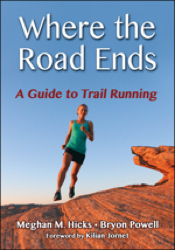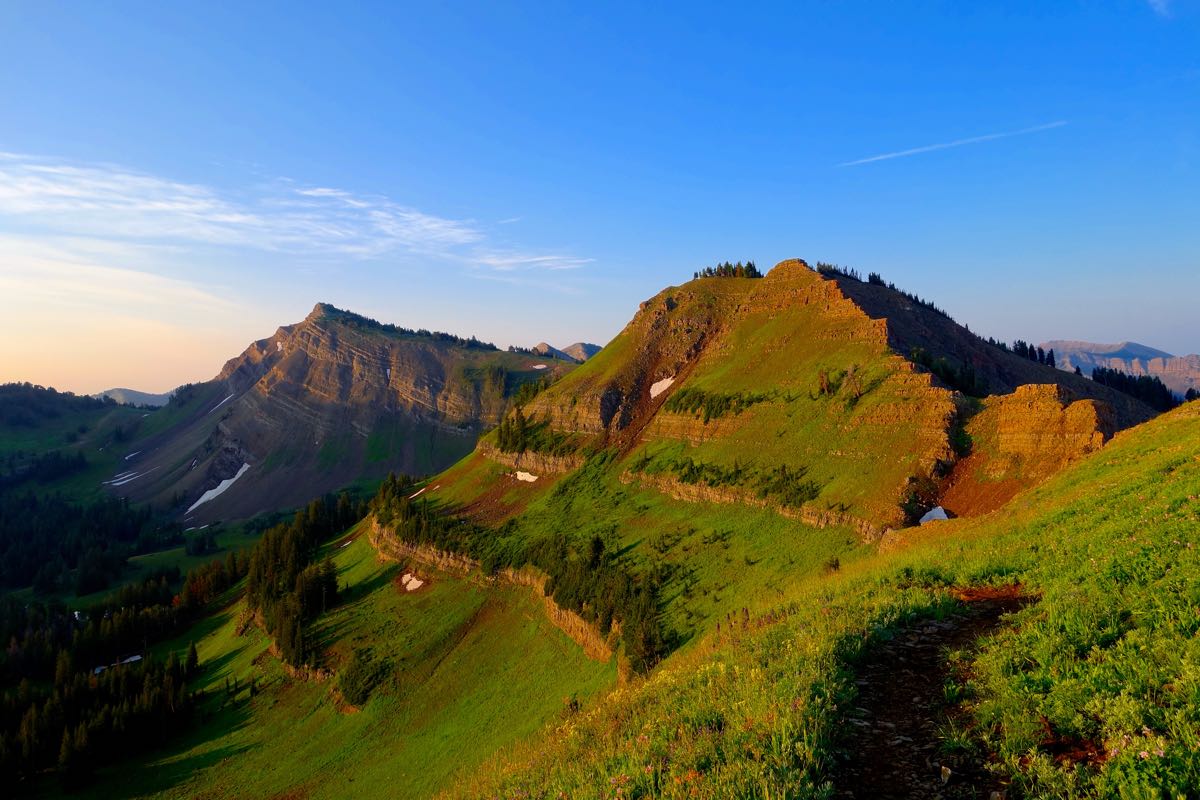
Like this article? Check out our book “Where the Road Ends!”
Welcome to this month’s edition of “Where the Road Ends: A Guide to Trail Running!” That’s the name of both this column and the book Meghan Hicks and Bryon Powell of iRunFar published in 2016. The book Where the Road Ends: A Guide to Trail Running is a how-to guide for trail running. We worked with publisher Human Kinetics to develop a book offering the information anyone needs to get started, stay safe, and feel inspired with their trail running. The book Where the Road Ends teaches you how to negotiate technical trails, read a map, build your own training plan, understand the basics of what to drink and eat when you run, and so much more.
This column aims to do the same by publishing sections from the book as well as encouraging conversation in the comments section of each article. We want you to feel inspired and confident as you take on your first few trail runs as well as connected to iRunFar’s community of trail runners! This month, we excerpt from Chapter 1, and answer some of the frequently asked questions people have as they try trail running for the first time.
Trail Running FAQs
Short, long, fast, slow, dirt, rocks, snow: It’s your turn to step on to the trail. As you begin your journey into this sport, you might find that you have some questions about what to do and expect. What follows should be enough information for you to enjoy your first trail runs. Let’s do this!
What Is Trail Running?
The short answer is that trail running is the sport of running off paved surfaces. The longer answer is that trail running is the act of running on an unending diversity of substrates: dirt, gravel, grass, wood chips, roots, rocks, sand, and more. Across flat ground, along rolling hills, up steep climbs, or down bomber descents—trail running is traveling over whatever terrain Mother Nature delivers. Trail running can include traveling short distances very quickly and long distances somewhat slower. It’s a sport in which your sweat comingles with dirt and mud. Trail running allows you to flow through shady forests, over treeless alpine terrain, atop steep cliffs, and through endless grasslands. It’s a sport whose community is strong and gritty but also filled with warmth and welcome. The sport is as much about running with interesting people or in beautiful places as it is about minutes-per-mile paces.
Is Trail Running Safe?
The sport of trail running has a small amount of inherent risk. We can fall on some types of terrain, and a normal trip and fall is always a possibility. Heat, snow, and other weather variations challenge us to keep our bodies warm, cool, or dry. Wildlife such as snakes or large predators add some risk when we run through their habitat. And as in life off the trails, dangerous humans always pose a small risk.
But anyone can acquire the knowledge, skills, and abilities to keep the risks of trail running very low. Chapters 10 and 11 of this book are devoted to giving you some of the knowledge you need to be a safe, smart trail runner.
How Do I Find Trails?
We bet you already know of trails near where you live. And if you don’t know about them, we bet they are not far away. Many urban and suburban parks have unpaved trails, sometimes extensive networks on which you can run for hours. Meghan, for instance, grew up in the suburbs of St. Paul, Minnesota, near a couple of parks. She ran on the paved bike path through one of these parks dozens of times before she noticed singletrack trails diverging into the woods from it. The trails weren’t marked and didn’t appear on any maps, but they were there. Bryon was raised in Titusville, New Jersey, northeast of Philadelphia, Pennsylvania. Washington Crossing State Park is located there. Its 3,500 acres (1,400 ha) are filled with the singletrack on which Bryon cut his trail running teeth as a youngster. Even in these developed areas, trails abound. Thus, our first words of advice for finding trails are to keep your eyes open. A bonanza of trails may already lie very close to your everyday haunts—you just have to discover them.
Next up, ask the experts at your local running store for trail information. Even if the store has a road running focus, surely at least one of its employees runs frequently on trails and will be happy to tell you about her or his personal playgrounds. If a visitor center or tourism office is located nearby, stop in. These places collect and collate all kinds of information for locals and visitors, and they may have trail maps and descriptions.
If you’ve exhausted your local, in-person resources and are still seeking information, check the websites of nearby conservation or recreation nonprofits and the websites for the agencies who manage any open spaces in or near your home.
Finally, the last (and sometimes best) source is Google Earth and Google Maps or even paper maps. These are truly wonderful tools for exploring your local landscape. You might find trails and a whole lot of other things you never knew existed in your town. Find the green spots and go.
Do I Need Special Shoes for Trail Running?
On the most fundamental level, you absolutely do not need special shoes to trail run. You can wear whatever athletic shoe you like on your feet to trail run, and chances are you will have an enjoyable outing. The simplicity of running is one of its greatest gifts, and trail running is no different.
As you start trail running, we recommend keeping things simple. Go for a run in a pair of sneakers you have lying around the house—maybe a pair of road running or hiking shoes. If you decide that trail running is up your alley, consider investing in a basic pair of trail shoes. Just as you would when buying athletic shoes, take the time to do your research and try on shoes at the store. First, buy a pair that feels good on your feet. Next, look for shoes that possess some basic trail running features that will improve your performance and confidence. Consider a trail shoe that offers protection to your toes with a toe bumper on the front of the shoe and to the bottom of your feet with a rock plate or extra cushioning. A rock plate is a device embedded in the sole of the shoe that prevents rocks from bumping or bruising the bottoms of your feet. Also, choose a trail shoe with some lugging on the outsole, the bottom of the shoe. This lugging should help you maintain traction on mud, wet rocks, or snow.
Do I Need Special Gear to Trail Run?
Just as with trail shoes, special gear isn’t a prerequisite for trail running. You can take your standard athletic apparel on the trails for a 30- to 90-minute run, and as long as the weather isn’t extreme, you’ll be perfectly happy.
But as with trail shoes, certain pieces of gear can enhance your experience. For example, a hydration pack to carry water, a bit of food, and a jacket will go a long way in making your body happy on a trail run that lasts a few hours. A waterproof jacket can extend your comfort on rainy or snowy days. Some runners find gaiters, which fit on your shoes to keep debris or snow out, a bonus in some conditions. A GPS running watch or a map and compass allow you to venture safely farther into the backcountry.
Do People Run on Trails at Night?
We sure do! In fact, trail running at night can be one of the most enjoyable aspects of our sport. We race at night, too. An appropriate lighting system is necessary for safe night running. Those starting out with night running may want to run in groups of two or more to minimize risk and to share in the experience.
How Do I Meet Other Trail Runners?
We think you’ll really like getting to know other trail runners and being part of the trail running community. Almost every decent-sized city or metropolitan area has a trail running group or at least an organized running group that spends part of its time on trails. All you need to do is find them. Many trail running groups are active on social media and the internet with a website, Facebook group, or Twitter feed. A quick Google search can link you with them.
Your local running store will also be a font of community information, as could be your local community or recreation center, gym, yoga studio, or CrossFit box. Many of these health-centered ventures have their own running groups or organize group runs, including trail runs.
Finally, perhaps the easiest place to meet trail runners is at a trail race, which leads to the next question.
How Do I Find Out About Trail Races?
In general, the same places that offer information about trails and trail runners will likely be able to inform you about trail races. Additionally, if the town you live in hosts trail races, the race director will likely advertise with posters on the bulletin boards of coffee shops, outdoor stores, libraries, and community centers.
Online, Trail Runner magazine’s website has a robust trail-race calendar that provides information on races out of town, out of state, and, sometimes, in other countries. Also, Google is a solid tool for locating the websites of nearby trail races.
Why Trail Running?
Wow. That’s a great question, and, perhaps, the least straightforward one of all to answer. We are all uniquely motivated in life, aren’t we? A survey of all of us trail runners about our motivations for spending time off road would yield widely varied results. Some of us trail run to be fit and fast, and to win races. Others trail run as means to relieve stress, to carve out “me time” from each day, and to instill confidence in ourselves. Still, more of us trail run so that we can spend time in nature, away from highways and skyscrapers. And some trail run to enjoy the company of the amazing people who do our sport.
As a two-time winner of the UTMB, Rory Bosio is one of the fastest female trail runners out there. However competitive she is, Rory finds deep joy in the act of running along a trail: “I love the simplicity of running. The act of putting one foot in front of the other is such a natural movement that one doesn’t need to be taught how to do it. Do you remember someone teaching you how to run? Probably not. As toddlers we progress from an unsteady walk to a full-on trot, no instruction needed. Running is ingrained in our DNA. Running outdoors provides an intimate connection with nature that at times feels magical. I live for that feeling of flow: speeding down a trail, opening up the stride, the worries of everyday life evaporating with every step, the clarity of the mind that comes from being truly in the moment, feeling enmeshed in the natural world as opposed to just being an observer of it, the body moving in harmony with the earth.”
Excerpted from Where the Road Ends: A Guide to Trail Running, by Meghan Hicks and Bryon Powell. Human Kinetics © 2016.
Call for Comments
- If you are trying trail running for the first time, what questions do you have?
- If you are an experienced trail runner, what can you remember from some of your earliest trail running? What do you know now that you wished you knew then?

